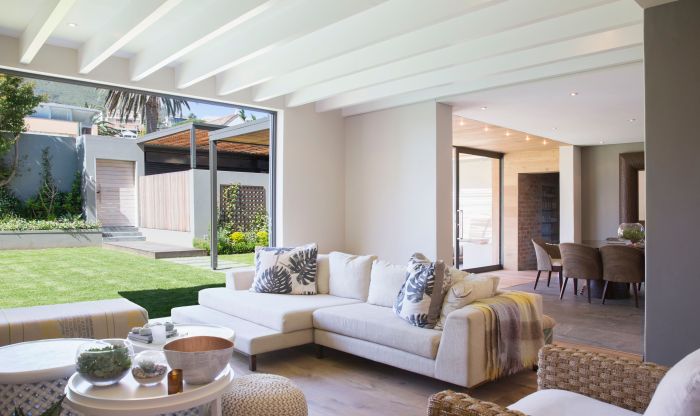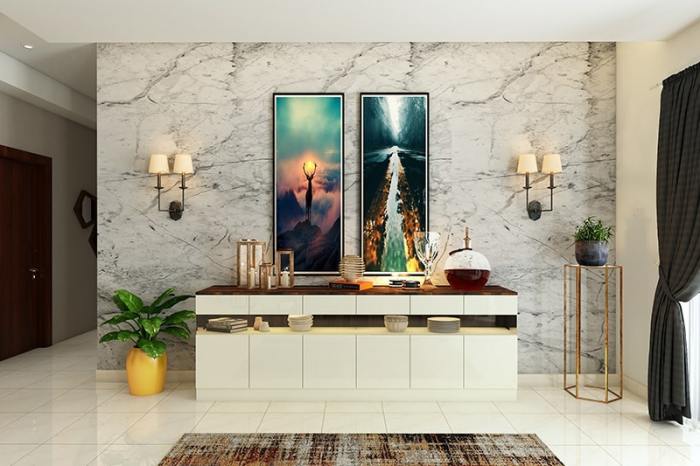Crafting an Inspiring Space: Exploring the Harmony of Decor and Design
As decor and design take center stage, this opening passage invites readers into a world shaped by expert knowledge, promising an immersive and uniquely original reading experience.
The following paragraphs delve into the intricacies of decor and design, shedding light on their dynamic relationship and impact on interior spaces.
Decor and Design Elements

Decor and design play crucial roles in interior styling, but they serve different purposes. Decor refers to the accessories and furnishings that enhance a space, such as rugs, curtains, and artwork. On the other hand, design involves the layout, functionality, and overall aesthetic of a space, including architectural elements and furniture placement.
Complementing Decor and Design Elements
Decor and design elements can work together to create a cohesive and visually appealing space. For example, a minimalist design with clean lines and neutral colors can be complemented by bold decor pieces like colorful throw pillows or statement artwork.
In this case, the decor adds personality and warmth to the space while the design maintains a sense of balance and harmony.
Significance of Incorporating Both Elements
Incorporating both decor and design elements is essential for creating a well-rounded and inviting space. Design sets the foundation for the overall look and feel of a room, while decor adds the finishing touches that reflect the homeowner's style and personality.
Without decor, a space may feel sterile and lack character, while without proper design, the decor may seem out of place or overwhelming. By balancing both elements, a space can achieve harmony, functionality, and aesthetic appeal.
Color Schemes

When it comes to interior design, color schemes play a crucial role in setting the tone and overall feel of a room. Different colors can evoke various emotions and create different atmospheres, making it essential to choose the right color palette for your space.Choosing the perfect color scheme for your design style is key to achieving a cohesive and harmonious look.
Whether you prefer a minimalist, bohemian, or modern aesthetic, selecting colors that complement each other and match the overall theme is essential.
Impact of Color Schemes
Color schemes can impact the overall design of a room in several ways. They can:
- Create a sense of harmony and balance
- Set the mood and atmosphere
- Highlight architectural features
- Make a space appear larger or smaller
Selecting the Right Color Schemes
When choosing a color scheme for your space, consider the following tips based on different design styles:
- For minimalist styles, opt for neutral tones like whites, greys, and beiges to create a clean and sleek look.
- For bohemian designs, embrace a mix of bold and vibrant colors paired with earthy tones for a relaxed and eclectic vibe.
- For modern interiors, stick to a monochromatic palette with pops of color for a contemporary and sophisticated feel.
Psychology of Colors
The psychology behind colors can significantly influence decor choices. Different colors can evoke specific emotions and feelings, impacting how we perceive a space. For example:
Blue is often associated with calmness and serenity, making it a popular choice for bedrooms and living spaces.
Understanding the psychology behind colors can help you create a space that not only looks beautiful but also feels inviting and harmonious.
Furniture Placement
When it comes to interior design, furniture placement plays a crucial role in determining the functionality and aesthetics of a room. The way furniture is arranged can greatly impact the flow of a space, as well as the overall feel and look of the room.
Importance of Furniture Placement
Proper furniture placement is essential for maximizing space and creating a harmonious environment
- Consider the function of the room: Before placing furniture, think about how the room will be used. This will help you determine the best layout for the space.
- Create a focal point: Arrange furniture around a focal point, such as a fireplace or a large window, to create a visually appealing and balanced layout.
- Leave room for movement: Ensure there is enough space for people to move around freely without obstacles. This will make the room feel more open and inviting.
- Balance the scale: Mix and match furniture pieces of different sizes to create visual interest and balance in the room.
- Consider traffic flow: Arrange furniture in a way that allows for easy traffic flow and access to doorways and windows.
Enhancing Functionality and Aesthetics
Strategic furniture placement can enhance the functionality and aesthetics of a room in various ways:
- Optimizing space: By placing furniture in the right locations, you can make the most of the available space and create a more efficient layout.
- Defining areas: Furniture placement can help define different areas within a room, such as a seating area, a dining area, or a workspace.
- Creating balance: Properly arranged furniture can create a sense of balance and harmony in the room, making it more visually pleasing.
- Adding personality: The way furniture is placed can reflect your personal style and add character to the room.
Lighting Design

Lighting plays a crucial role in decor and design, as it has the power to transform the mood and ambiance of a space. Proper lighting design can enhance key design elements, highlight focal points, and create a welcoming atmosphere.
Types of Lighting Fixtures and Their Effects
There are various types of lighting fixtures that can be used to achieve different effects in a space:
- Ambient Lighting: Provides overall illumination and sets the tone for the room.
- Task Lighting: Focused light for specific activities like reading or cooking.
- Accent Lighting: Highlights artwork, architectural features, or other focal points.
- Decorative Lighting: Adds visual interest and serves as a decorative element in the space.
Accentuating Key Design Elements
Lighting design can accentuate key design elements by strategically placing fixtures to draw attention to certain areas. For example, using track lighting to highlight a gallery wall, or installing a statement chandelier to add drama to a dining room. The interplay of light and shadow can also create depth and dimension in a room, emphasizing textures and colors.
Epilogue
In conclusion, the fusion of decor and design creates a harmonious environment that speaks volumes about personal style and creativity. Dive into your own decor and design journey and watch as your space transforms into a reflection of your unique taste and vision.
FAQ Corner
What is the difference between decor and design?
Decor involves adding finishing touches and accessories, while design focuses on the layout and functionality of a space.
How do color schemes impact room design?
Color schemes can evoke different moods and aesthetics, influencing the overall look and feel of a room.
Why is furniture placement important in interior design?
Proper furniture placement enhances both the functionality and visual appeal of a room, creating a balanced and inviting space.
What role does lighting play in decor and design?
Lighting can highlight key design elements, set the mood, and enhance the overall ambiance of a space.